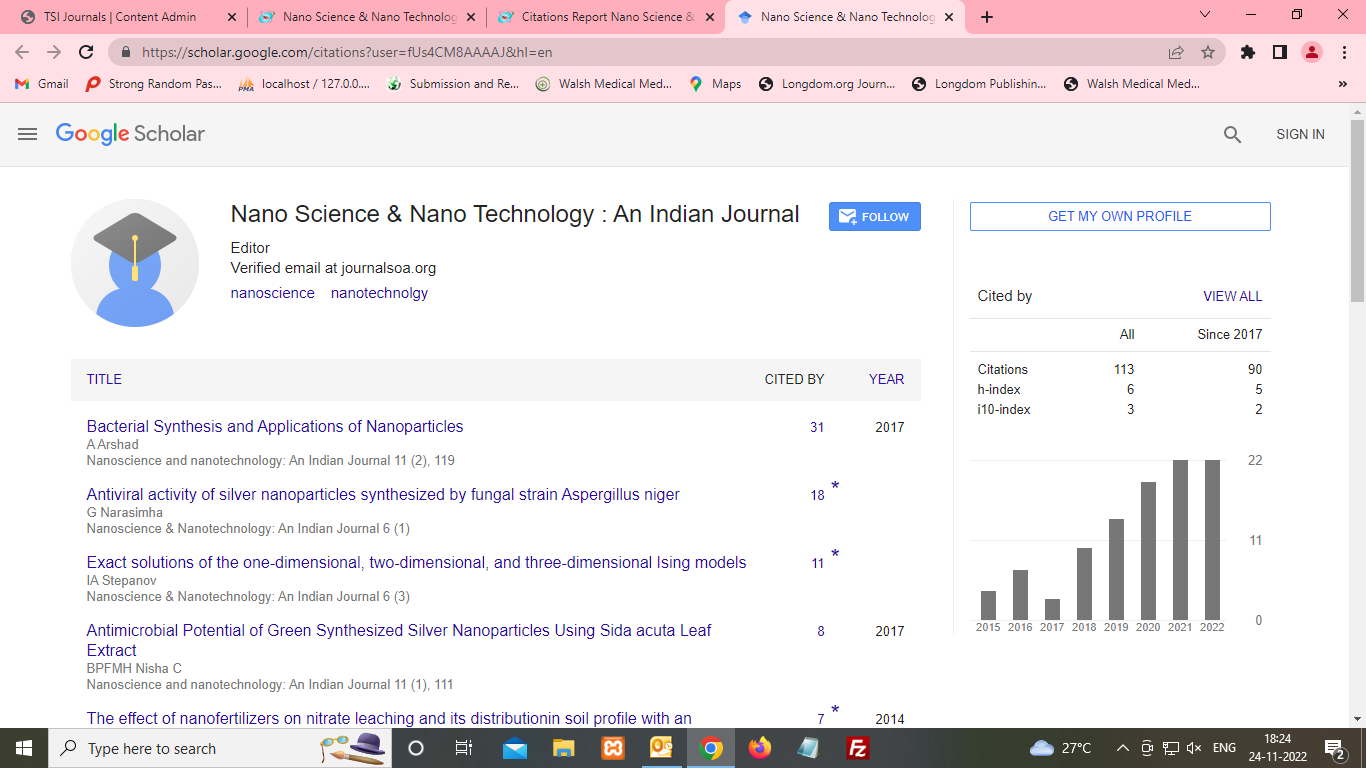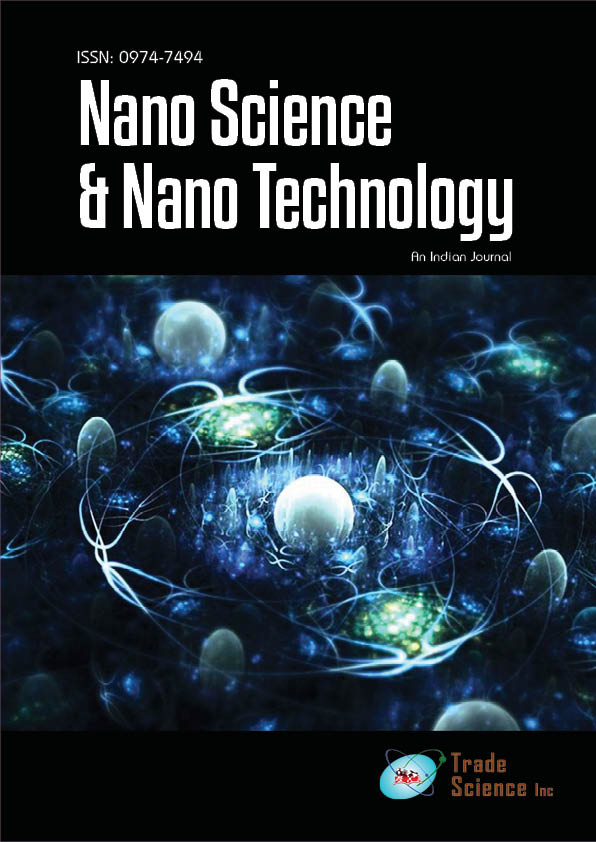Current opinion
, Volume: 16( 5) DOI: doi: 10.37532/ 0974-7494.2022.16(5).165Agricultural and pharmaceutical industries' use of nanomaterials
- *Correspondence:
- Alina Catherine Nanoscience & Nanotechnology: An Indian Journal, UK,E-mail: cathalina@gmail.com
Received: Sep 2, 2022, Manuscript No tsnsnt-22-81668; Editor assigned: Sep 4, 2022, PreQC No tsnsnt-22-81668 (PQ); Reviewed: Sep 16, 2022, QC No tsnsnt-22-81668 (Q); Revised: Sep 19, 2022, Manuscript No tsnsnt-22-81668 (R); Published: Sep 30, 2022, doi: 10.37532/ 0974-7494.2022.16(5).165
Citation:Catherine A. Agricultural and Pharmaceutical Industries' Use Of Nanomaterials. Nano Tech Nano Sci Ind J. 2022; 16(5):165. .
Abstract
Recent advancements in science, such as nanotechnology, have been among the most fascinating. Much interest has been shown in the metal nanoparticles produced by nanotechnology. This field is rapidly developing as a result of its practical applications, which are focused on the production of novel materials at the nanoscale level. In a number of industries, including agri-food and biomedical products, nanomaterials are gaining a lot of attention.
Introduction
Recent advancements in science, such as nanotechnology, have been among the most fascinating. Much interest has been shown in the metal nanoparticles produced by nanotechnology. This field is rapidly developing as a result of its practical applications, which are focused on the production of novel materials at the nanoscale level. In a number of industries, including agri-food and biomedical products, nanomaterials are gaining a lot of attention. Nanomaterials have a wide range of uses in the agri-food sector, including as fertilizers, insecticides, herbicides, sensors, and quality enhancers. They can also be used in food processing, packaging, and nutraceuticals to boost nutritional value. The crop quality and yield are increased as a result of these agricultural uses, and the pollution that many chemicals produce is decreased.
By encapsulating active chemicals in food, nanotechnology has the potential to improve functional foods and nutraceuticals. Nanoparticles between 1 nm and 100 nm in size are typically used in nanotechnology. The basis of nanotechnology is the adoption of new, frequently preferable properties by materials that are smaller than usual but have more surface area. A few fields where nanotechnology can be applied include medicine, agriculture, food science, food technology, recreation, and civil engineering. There is a lot of potential for nanotechnology in many fields, and some applications have already shown to be profitable for both consumers and businesses. Engineers have used nanotechnology to produce products that are stronger, lighter, impervious to rust, and resistant to fire and stains.
Nanomaterials in the agricultural food sector
One of the most cutting-edge technologies in the agricultural and food sectors has been nanoscience. The agrifood sector can use nanomaterials in a variety of ways, including Nano formulations for crop improvement, crop protection for disease detection, Nano devices for plant genetic engineering, plant disease diagnosis, and other uses. Numerous nanoparticles have been used to encourage the growth and development of agricultural food plants. This beneficial effect has led to an increase in germination percentage, biomass production, and physiological parameters like photosynthesis and nitrogen metabolism in many food crops, including alfalfa, cucumber, corn, lettuce, onion, pumpkin, ryegrass, rape, radish, spinach, soybean, tomato, and wheat. Because it makes everything simpler, from diagnosing illnesses to delivering medications to human organs to fight infectious infections, nanotechnology is important in biomedical and pharmaceutical products. Nanoparticles have special biological properties that can be used for disease detection, prevention, and treatment, drug delivery, and gene therapy for cancer and pulmonary diseases. This is because they can bind, absorb, and carry small-molecule drugs, DNA, RNA, and proteins with high efficiency. Indeed, Kaposi's sarcoma, ovarian cancer, and breast cancer have all been successfully treated with liposomal drug formulations (like doxorubicin). Liposomal drug formulations for amphotericin and hamycin cancer drugs demonstrated much greater efficacy and safety as compared to conventional preparations.
Nanomaterials have been included into medicinal formulations as active components (nanocrystals), excipients (drug-metal complexes), drug transporters (liposomes), and complexes/conjugates (drug-protein). In the future, nanotechnology might provide advantages for dietary health. An insulin-containing biodegradable substance that has undergone Nano engineering should be ingested by people with type 1 diabetes and released when blood glucose levels rise. The application of anti-inflammatory drugs produced from nanotechnology to the mucosal lining of people with Crohn's disease or inflammatory bowel disease has also aroused interest. It has also been hypothesized that manipulating specific nutrients with nanotechnology may enable people to have a wider range of food preferences and tolerances.
The food industry and nanomaterials
Improved and novel food concepts that go beyond what is currently feasible could be made possible by nanotechnology. Examples of industries where they might be used include agriculture, food processing, food packaging, and supplements. Nano sensors could be used in food packaging to alert consumers when food is no longer edible or to stop microbial invasion. Utilizing nanotechnology, food can also be improved for consumer health. Nanomaterials in food can be "soft" or "hard," respectively. When natural products or food ingredients like homogenized milk, ricotta cheese, and coenzyme are prepared, soft nanoparticles are produced. Alternatively, the Food Standards Agency is more concerned with nanoparticles. The properties of these insoluble materials are poorly understood. Nanomaterials that are hard include metals, for instance. According to the FSA, the "Novel Foods Regulation" would require that foods and practices using nanotechnology receive the same approval as they do now.

